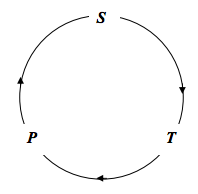15.2: Adiabatic Decompression
( \newcommand{\kernel}{\mathrm{null}\,}\)
We are going to calculate an expression for (∂T/∂P)S. The expression will be positive, since T and P increase together. We shall consider the entropy as a function of temperature and pressure, and, with the variables

we shall start with the cyclic relation
(∂S∂T)P(∂T∂P)S(∂P∂S)T=−1.
The middle term is the one we want. Let’s find expressions for the first and third partial derivatives in terms of things that we can measure.
In a reversible process dS=dQ/T, and, in an isobaric process, dQ=CPdT. Therefore
(∂S∂T)p=CpT.
Also, we have a Maxwell relation (Equation 12.6.16). (∂S∂P)T=−(∂V∂T)P. Thus Equation ??? becomes
(∂T∂P)S=TCP(∂V∂T)P.
Check the dimensions of this. Note also that CP can be total, specific or molar, provided that V is correspondingly total, specific or molar. (∂T/∂P)S is, of course, intensive.
If the gas is an ideal gas, the equation of state is PV=RT, so that
(∂V∂T)P=RP=VT.
Equation ??? therefore becomes
(∂T∂P)S=VCP.


